On Sunday night November 22nd, I had my first opportunity to visit the AFI Silver Theatre in Silver Spring, MD along with a few friends as we celebrated a birthday. We attended a screening of the new documentary L'enfer d'Henri-Georges Clouzot which offers a look at L'enfer, his unfinished penultimate film project from 1964.
The link below features Richard Peña from the Film Society of Lincoln Center explaining the backstory of the abandoned project.
The story featured a love triangle between Marcel -a moody jealous husband portrayed by Serge Reggiani, his wife Odette as played by Romy Schneider, and Martineau a lover played by Jean-Claude Bercq. This unfinished exercise in fun, frolic and internal psychological fear was to be played out upon a scenic resort hotel location next to a lake and an immense bridge which dwarfed everything which existed below it.
L'enfer was intended to be a film that mixed black-and-white with color footage as the story would dictate.
This still shows an example of the monochromatic day-to-day story. It is not only an exterior location, it is also a graphic statement of the overarching complications that plague Marcel in an external representation.

The depiction of Marcel's jealous nature, his arousal, his interior thoughts and obsessive and disturbing moody point of view would be subjectively conveyed in color as in the frame below.
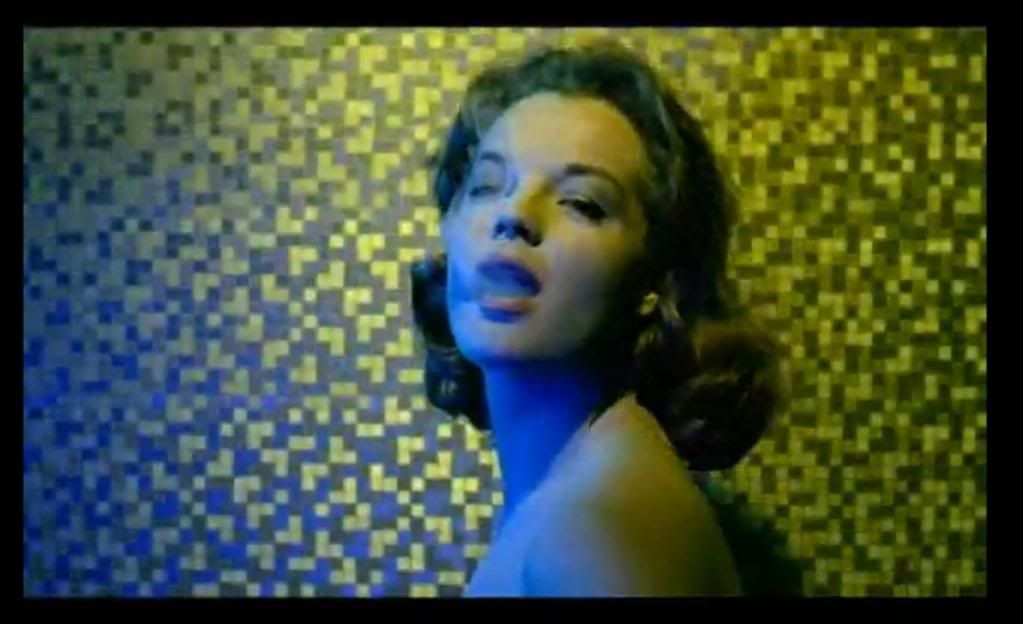
In the shot above from the L'enfer camera tests, Romy Schneider is standing against a visually dynamic, electrically-charged mosaic background.
This brings to mind a similar shot of Tippy Hedren in Hitchcock's Marnie
(also from 1964 but obviously a completed film released to the public).
In the frame below we see Marnie making a bit of a turnaround in her life.
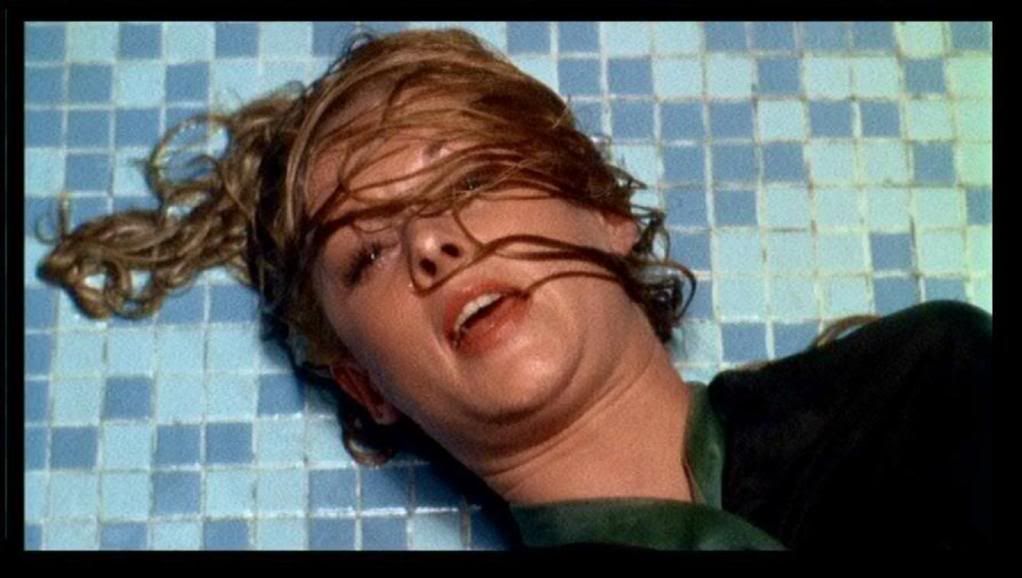
This still shows an example of the monochromatic day-to-day story. It is not only an exterior location, it is also a graphic statement of the overarching complications that plague Marcel in an external representation.

The depiction of Marcel's jealous nature, his arousal, his interior thoughts and obsessive and disturbing moody point of view would be subjectively conveyed in color as in the frame below.

In the shot above from the L'enfer camera tests, Romy Schneider is standing against a visually dynamic, electrically-charged mosaic background.
This brings to mind a similar shot of Tippy Hedren in Hitchcock's Marnie
(also from 1964 but obviously a completed film released to the public).
In the frame below we see Marnie making a bit of a turnaround in her life.

Marnie's husband Mark Rutland (Sean Connery)
discovers that she is missing from their cabin and
he is seen running alone aboard the exterior levels of the cruise ship.
He finds her floating face down and lifeless upon the surface of the swimming pool on the top deck, and he
dives in to rescue her from drowning.
He is equal to the physical demands of lugging her torso under his left arm, and as they ascend the pool ladder, he then places her body upon the mosaic floor lying facedown.
He pumps her back a few times to expel the water from her lungs and turns her over to the right.
Tired but grateful and slightly chiding her latest act of rebellion as if a parent to his child, Mark asks her
" Why the hell didn't you jump over the side?"
Marnie replies " The idea was to kill myself not feed the damn fish."
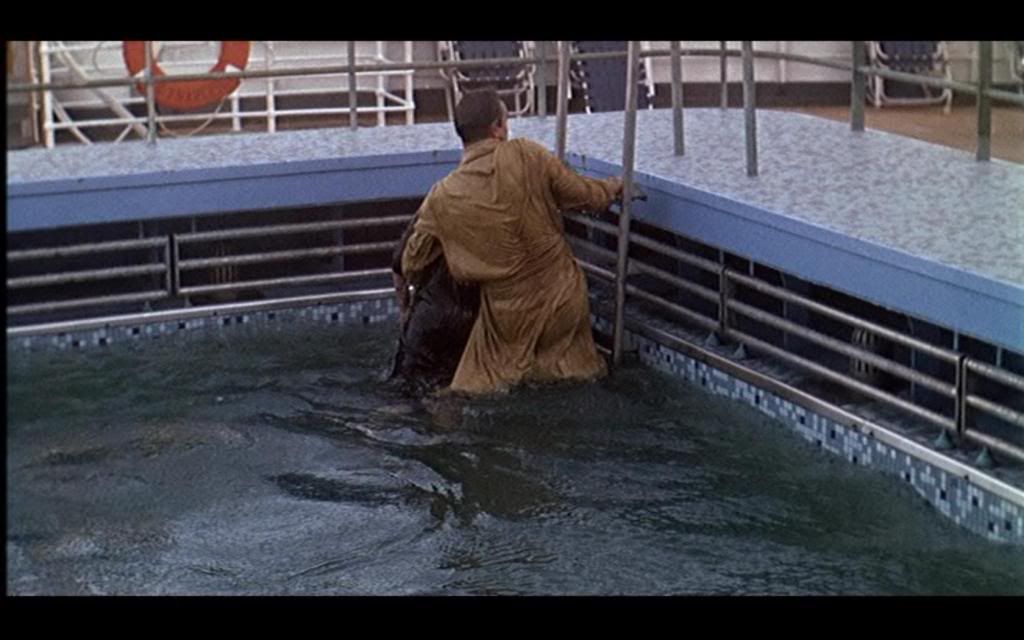
The action in the frame above where Mark saves Marnie is a visual reversal of fortune from the opening scene of the film where we are introduced to a mysterious woman as seen from behind.
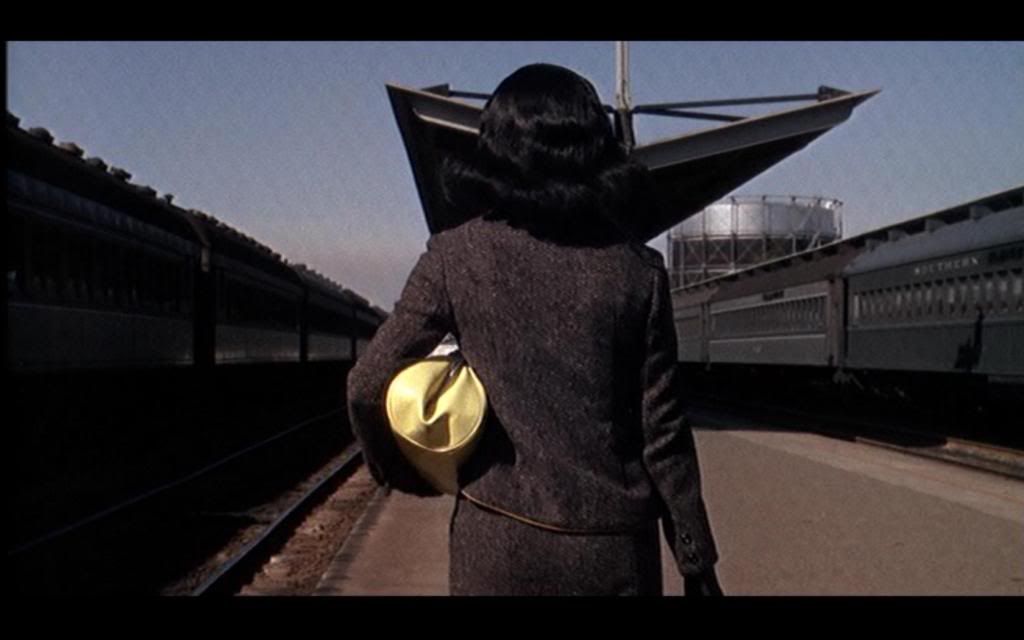
Here we are seeing Marnie in control; hidden inside her closed purse is the money, power, and dominance that she has stolen from the helpless men that she has swindled and duped.
In a morality tale, no matter where you place the locus of a businessman upon a scale of reference as to good and evil, the conceit of "money means everything" strikes a universal chord in the audience. Like men have always lived their lives, because Marnie controls the gold, she makes the rules of the game - and she always walks away a winner. The loot is safely tucked away under her protective arm.
This symbolic representation of Marnie's character via the color and shape of her purse, this containment of her repressed sexuality, and her personalized reconfiguring of the male-female power struggle is yet another example of how Hitchcock and the screenwriter in his films are able to make a statement of an idea which is endlessly visually fascinating to the audience.
As a point of visual reference, it willingly leads the viewer into the story and into the distance of the exterior train station framing.
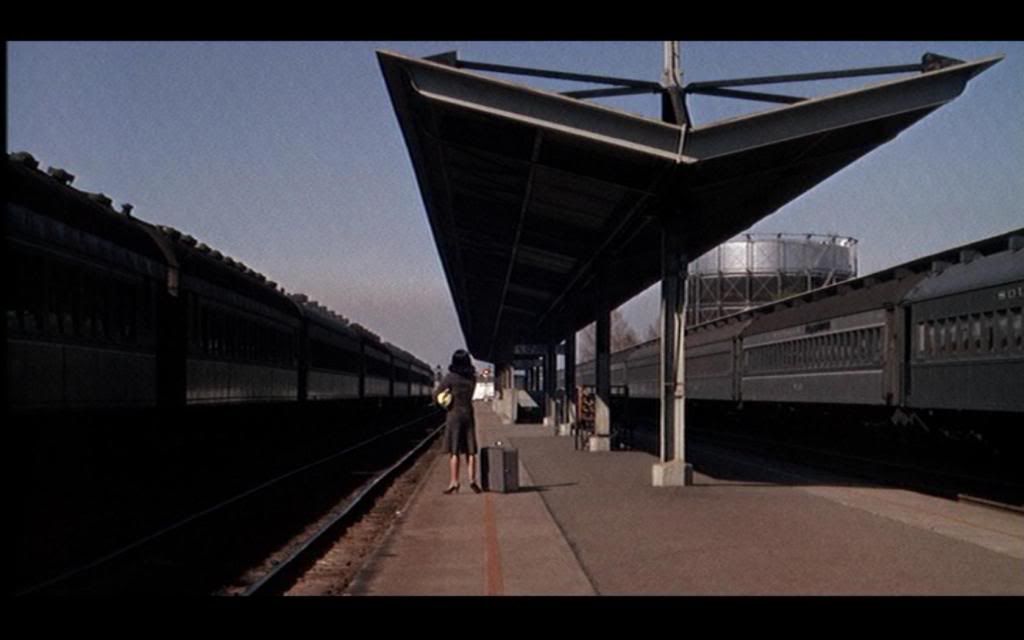
In the extreme distant background of the film frame, just prior to the cut to the next scene, if we examine it closely we see a tiny suggestion of a story point to ultimately be reached by the character and viewer alike.
What appears to be a circular red sign with a signal light is visible just to the right of Marnie's shoulder.
This form is slightly smaller than the circular off-yellow form of her purse under her left arm.
The lines that inform the frame and create a visual sweep towards a vanishing point in the background are pointing towards a pair of choices for this character to make.
The faded line that Marnie walks upon as she moves away from us,
leads our eye directly past the luggage that she has placed on the platform.
The line leads our eye beyond the luggage to the red circular signal.
To the left of Marnie's shoulder is a signal with a green light.
Marnie stands to the left of the red line.
Marnie leads a dual life and as human beings we all have choices to make.
Perhaps the colors of the signals are a subliminal indication of the choice she will be making as she reaches her destiny.
If we return to the shot of Mark saving Marnie in the pool, to the upper left of frame we see a pale red life saver.
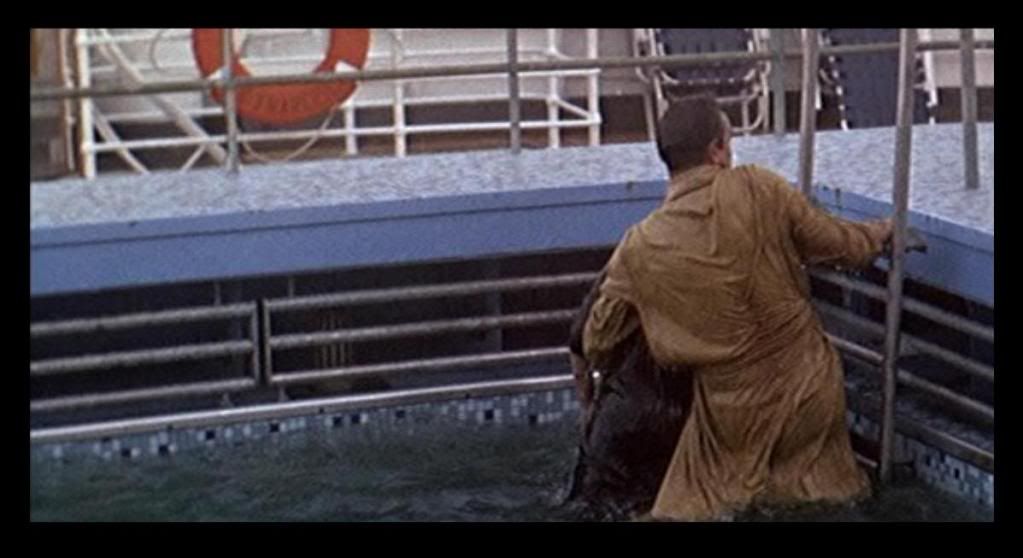
The meaning of the color red has a special significance for Marnie. These scenes and the circular forms within it contain traditional methods of providing stepping stones toward overall comprehension as both the viewer and Marnie follow her path towards an ultimate desire; a journey that is assisted by the compassionate love of her partner, on a conversion towards finding wellness at the end of the film.
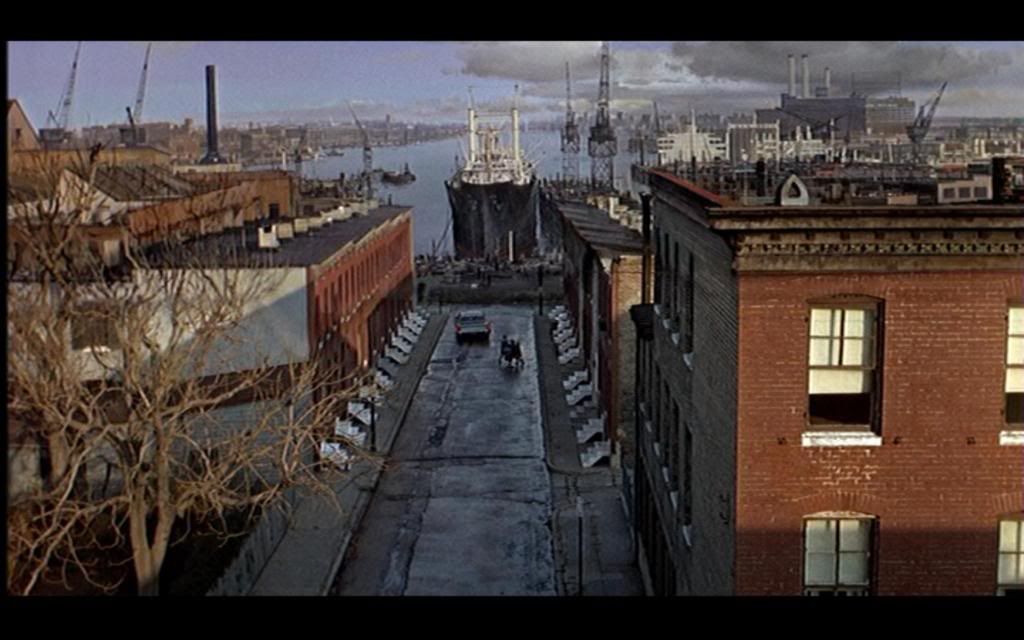
DOWNTOWN BALTIMORE CIRCA 1963-64
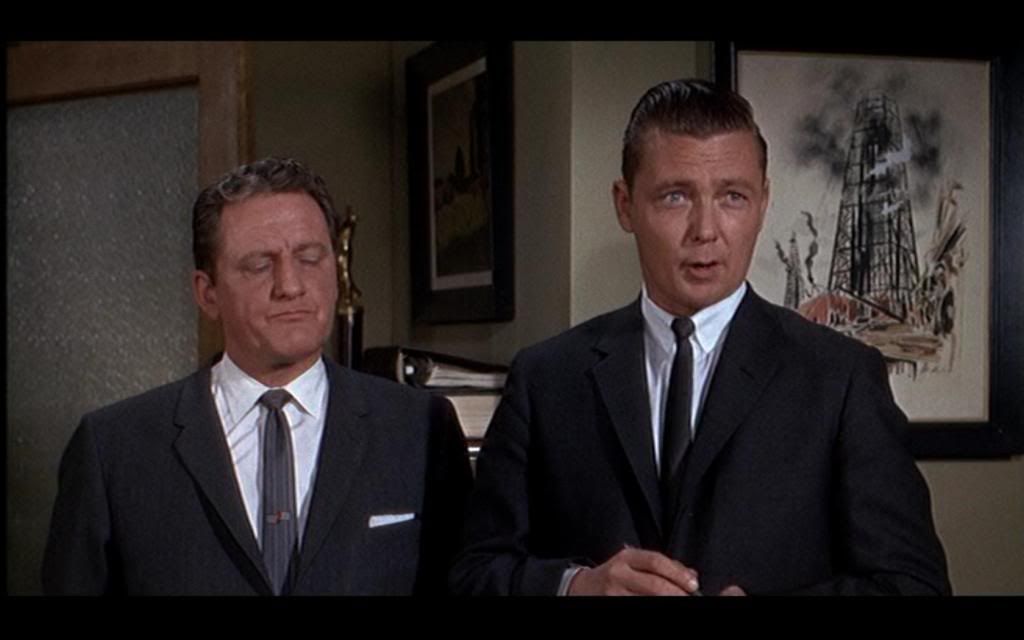
I have not read Winston Graham's novel Marnie which was the source material for the film, and I don't know if there was a suicide scene in a swimming pool.
It is common knowledge among film fans that Clouzot beat Hitchcock to the punch when Hitch lost out on buying the rights to film Diabolique, and Hitchcock was a big fan of Clouzot's film.
Perhaps the use of the pool was not only an item of interest or convenience in creating the screenplay of Marnie, but it was also a way to acknowledge an element used in Diabolique and a suggestion of the mutual admiration society that Clouzot and Hitchcock shared.
In this frame below from the opening minutes of Marnie, art director Robert Boyle has placed a framed print of an oil well upon Mr. Strut's office wall that references the current state of mind that Strut is in. It suggests money and power and - to my eye - an icon from Clouzot's The Wages of Fear.

Clouzot became lost in his obsessions and personal demons on L'enfer, and despite his having the luxury of a large budget with no oversight, three top camera crews and other devoted personnel, he suffered a heart attack and the project was soon dropped after three weeks.
If you are a fan of thrillers and you appreciate the expertise he employed in The Wages of Fear and Diabolique, his best known films, when you see what has crept out of the vault in this documentary, you can imagine how powerful the finished product might have been.
Rather than just read about this historical miscue, thankfully we get to see some possibilities being fleshed out; the documentary intercuts recently shot footage of two actors performing scenes from the script along with some of the camera tests, interviews with crew members and production footage that was shot back in 1964.
Serge Bromberg as the writer and co-director along with Ruxandra Medrea have given us a gift by allowing the notion and nature of the lost film to be resurrected from the grave.
There will always be dream projects which are never completed.
Prior to his death Sergio Leone was putting into place the financing and crew for a project about Leningrad which ultimately might have been entitled Once Upon a Time in Russia - being Leone, it could have been epic with a capital "E."
When Stanley Kubrick died he left behind a body of masterworks and a handful of abandoned projects including a massive amount of research on the life of Napoleon which he was unable to film.
If you are feeling flush with cash to the tune of $700 US, you can buy the limited edition book at Amazon which is entitled "Stanley Kubrick's Napoleon: The Greatest Film Never Made."
Hitchcock had his share of unrealized projects including his version of The Wreck of The Mary Deare.
The one that hurts the most as a Hitch fan is the obstacles he encountered in making Kaleidoscope Frenzy.
Had he been able to go ahead and make the picture, it appears that Hitchcock would have made a critical and financial comeback from the failures of Marnie and Torn Curtain at about the same time as the release of Bonnie and Clyde or In Cold Blood.
Some of the ideas that originated in his failed Kaleidoscope project were reworked a few years later in Frenzy.
Clouzot has often been referred to as "the French Hitchcock," and like Hitch with Frenzy, apparently this is also what happened with Clouzot when he employed some of his L'enfer ideas in his final film from 1968 La prisonnière.
Two of the films on my must-see list are La prisonnière and the Claude Chabrol 1994 release of L'enfer which is based on Clouzot's original 1964 script.
We take it for granted that there is a freedom and ease with which we can create fantastic visual effects in 2009 on a home computer which are clearly more modern than the visual experiments that we observe in the L'enfer camera tests. But our technological advantage does not completely erase or obscure the efforts of those who have gone before us, especially a man like Henri-Georges Clouzot.
The psychedelic, dreamy and weird visual forays in these tests show the current influences of modern art from the early 1960's but although they are artifacts of that time, they still convey introspection, perplexity, and a twisting of time and meaning for the character and the observer to parse.
The fires of L'enfer may have consumed him but the real life story of this production is another classic example of an artist seeking a breakthrough at a great cost to himself and to the backers. It seems to me he lived out his nightmare and his dream at the same time.
In the production footage of L'enfer, when we see the scenes of a man running along the road towards the tracking camera that observes his pursuit, as the background of his past flows away we can see and feel the urgency of the quest.
Whatever he is running away from, and the unknown that he is running towards are the bookends that contain Henri-Georges Clouzot as he is being driven to find whatever it was that he was looking for.
When we see the camera tests, I think within these tests he had found "it" or parts of it, but in his devotion to his quest he could not see whatever was right with what he had found and he lost it again.
Stranger things have happened but I think it would be wonderful if somehow in our lifetime, the existing footage of L'enfer could be made available to purchase as a software game or puzzle. It could provide entertainment and artistic self-discovery to the film fan - a means to exploring editorial decisions for fun in your own home. Cue up the Talking Heads "Burning Down the House" and let the Disco Clouzot Inferno home game begin....
The documentary score composed by Bruno Alexiu was just right; a moody rainy day jazz score which I found to be a perfect match for this wandering work of art. A cd release of the score needs to be released and it would provide a perfect complementary rememberance of Clouzot and L'enfer.
